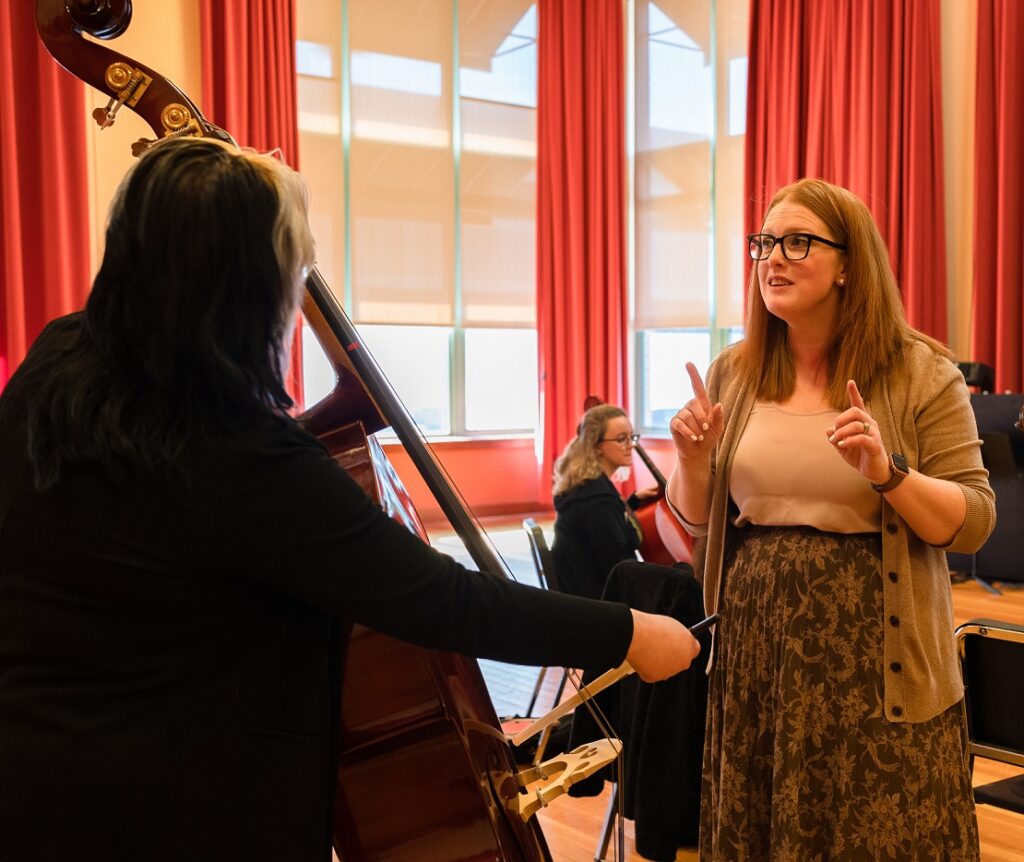Develop Atomic Habits for Your Program
A key to success is to have a consistent system of routines that you and your students follow.
Look into any successful music program, and you’re bound to find some sort of system. Teachers may use different method books, classes may look different, and students may be playing different music, but successful groups often have a system of routines and habits that teachers and students rely on.
There are many great publications on habits, such as “The Power of Habit” by Charles Duhigg and “The Seven Habits of Highly Effective People” by Stephen R. Covey. Every book and system have their pros and cons, and you can spend countless hours vetting the ideal system for your group. However, it’s more important to get something in place, so you can get to work. For our purposes, I’m going to use James Clear’s book, “Atomic Habits,” which was published in 2018.
The quick summary of “Atomic Habits” is that there are four elements to creating a habit:
Make it Obvious
 Making habits obvious in a music class begins by simply being aware of habits that you want to break and habits that you want to build.
Making habits obvious in a music class begins by simply being aware of habits that you want to break and habits that you want to build.
Let’s start with a very obvious one: phone use during rehearsal. I used to be OK with students having their phones on their stands because I naively thought that “they could use them for tuning!” And yes, they did use their phones for tuning, but guess what? Phones are made to be convenient (and attractive, easy and satisfying…), so students also took the extra few seconds to check any notifications that came in, which then led to more and more phone use during what they perceived to be downtime in rehearsals.
The class as a whole had to address the phone being so obvious, attractive, easy and satisfying to use. I knew that I could not compete with the limitless informational and connectivity opportunities that a phone has. So, the decision was made: Phones could not be used at all during rehearsal.
Student: “How will I tune now?”
Me: “I have tuners you can borrow.”
Student: “What if my mom texts me during class?”
Me: “Then I can just make two copies of the handbook outlining the rules on phones.”
For habits you’d like to build, make them obvious by thinking about locations. For example, I told my ensemble that I wanted to begin each day with a new tuning exercise. We did the exercise a few times, but we quickly forgot about it because it was, well, new. We solved this with a very quick and easy solution: At the end of class, students were instructed to put the tuning exercise in the front of their folder before they left. The next day, I went back to my old routine of starting with our previous exercise and was immediately met with 60 students holding up the new exercise.
Make it Attractive
Start with a habit that we like the most, and you and your class will be more inclined to continue with the habit. Is there a certain musical exercise or piece that your group likes? For some groups working on simple theory in musical ensembles or using the ensemble’s favorite piece can be a good start to identify keys and phrases. If you have access to music teaching software, such as the MusicFirst suite, these can be great habit-forming games. My son wasn’t crazy about math at first, but he’ll play the Prodigy math game that his school promotes every day.
Once students get used to working on some habits and routines consistently, they can move toward other areas. If you can help students make it a little fun, this can go a long way.
THE YAMAHA EDUCATOR NEWSLETTER: Sign up to receive real-word advice, tips and classroom guides!
Make it Easy
 Our exercises are selected ahead of time. For my group, I use exercises from the following books:
Our exercises are selected ahead of time. For my group, I use exercises from the following books:
- “Important Ingredients” by Daniel Moore
- “Foundations for Superior Performance” by Richard Williams and Jeff King
- “Basic Training for Concert Band” published by Bravo Music
How do I make this easy? My program purchases a copy of these books for every student, and they are in their folders from the beginning of the school year. I also make this easy for students by printing out a list of the most common exercises we will use from each book. You can go a step further and have students put multi-colored sticky notes on common pages.
Our system is also made attractive for members of our program due to the variety. If students get tired of one specific exercise, we can choose an articulation exercise from another book.
Try making a simple goal that can be achieved. Let’s say you want to do more sight-reading. Doesn’t sight-reading a piece a day sound good? But an entire piece can be difficult to deal with. What if your initial goal was to simply sight-read one measure per day? It might sound a little goofy, but it’s achievable.
You’ll find that on some days, you sight-read the one measure, and that’s enough — check and done! — because you need to focus on the upcoming concert or other big event. But on most days, you’ll find that sight-reading one measure is the little bit you and your students need to motivate yourselves to continue. The students will then say, “If this music is out already, why not just sight-read the rest of it?”
I find myself doing the same in my personal life. If I want to make a goal of reading, my goal is one paragraph. Most days this turns into at least 20 minutes of reading. But a few days a month, I meet the minimum requirement and move on.
Make it Satisfying
 No one will continue with a habit if there is no payoff, which can be intrinsic or extrinsic. Unfortunately, with music, it’s difficult to pinpoint short-term payoffs. I suggest starting with an external reward but don’t announce this to the kids. Rather, commit to an extended time working through your habit or routine, and then surprise your students with the reward. For some groups, the timeline might be a week, and for others, it might be six months.
No one will continue with a habit if there is no payoff, which can be intrinsic or extrinsic. Unfortunately, with music, it’s difficult to pinpoint short-term payoffs. I suggest starting with an external reward but don’t announce this to the kids. Rather, commit to an extended time working through your habit or routine, and then surprise your students with the reward. For some groups, the timeline might be a week, and for others, it might be six months.
I’m not a big fan of using candy, pizza parties, etc. as rewards, but you know your group best. In my case, the goal — or habit — was to sight-read more. We sight-read musical examples everyday for over a month. The students had also been asked to read some popular film music like “Star Wars” or “The Incredibles,” which became a sort of interim reward.
The big reward was a piece that had quite a few elements in it that we had already sight-read. In one class, the students did their typical routine. I then announced that we had been consistent with our sight-reading goal for over 30 days and that when you work hard on something, you get the opportunity to work harder but you also feel more accomplished. I then handed out the piece, which was “Dance of the Jesters” by Tchaikosvky, and we sight-read it. The students instantly noticed that they could sight-read this full piece much better than they normally could, and they were happy to have a working break from our typical concert music. Plus, sight-reading this piece also continued our habit!
Keep it Consistent
Consistency is the easiest — and hardest — part. It’s easy because all we have to do is follow our plan every single day.
It’s hard for a multitude of reasons. Many people get bored with the same routine. Combine that with unrealistic expectations of progress (hard reality: It takes a long time to get better at things in the intermediate to advanced stages), and it’s a surefire way to become discouraged quickly. On top of that, sometimes we have issues come up at school, such as fire alarm drills or classroom interruptions that throw off your routine.
Keeping things consistent has a lot to do with accountability. As mentioned above, moving the specific exercise to the front of the folder created an opportunity for students to hold me accountable. It also helped the class to make sure that the routine and habit that we were trying to form became a priority. This action resulted in doing and completing the habit earlier in the rehearsal or class time as opposed to the end when time can run out or other time burglars can wedge themselves in.
 According to a blog post by Clear, comedian Jerry Seinfeld has a strategy called “don’t break the chain” to combat procrastination. On a large wall calendar, mark each day that you complete the habit you want to instill with a large X. Seeing consecutive days and weeks with Xs will motivate you to not “break the chain.” This strategy has worked wonders for my group and me. The visual representation of our habits has encouraged us to push through the tough times.
According to a blog post by Clear, comedian Jerry Seinfeld has a strategy called “don’t break the chain” to combat procrastination. On a large wall calendar, mark each day that you complete the habit you want to instill with a large X. Seeing consecutive days and weeks with Xs will motivate you to not “break the chain.” This strategy has worked wonders for my group and me. The visual representation of our habits has encouraged us to push through the tough times.
However, we’re not perfect, and we may miss a day. While we should avoid this at all costs, it’s not the end of the world. Clear states that we get into big trouble with habits when we miss two days in a row. If you miss a day, don’t beat yourself up over it, but do make it a priority to jump right back in as soon as possible on day two. Looking back, I’ve had many habits that I tracked for over a year and then I missed two days. It took me a good two or three months to get back into that habit.
If you find yourself having difficulty keeping things consistent, consider stepping back and looking at what you are doing. You may find that you have simply enacted too many new habits or the habits you have are too big. Consider breaking down these habits into smaller, more manageable chunks. Five-note scales instead of eight, sight-read one line of music instead of a piece, two minutes of articulation drills instead of five, etc.
Avoid the Pitfalls
When it comes to making habits stick, pitfalls exist. If I’m sick and taking antibiotics, I might be less inclined to finish the medicine if I start to feel better. Of course, this could result in me not fully treating the illness and becoming sick again. I think habits are similar in that just when things get better in my band, we tend to want to stray from the hard work we had implemented. Don’t do this! This is the time when it gets good, so push yourself and your students to continue and show that consistency pays off.
Things can also get, well, boring. Doing the same thing every single day can begin to feel like a chore — it’s still obvious and easy, but it is no longer attractive and it no longer feels satisfying. During these lulls, I recommend alternate approaches that meet the same goal. Have a few different articulation exercises or chorales to cycle through to ensure that there’s enough interest to continue.
Another pitfall is doing too much too soon. When I’m in the mood to be productive and change something, I end up wanting to change as many things as possible. This quickly becomes overwhelming, and my focus is going in too many directions at once. Many music educators are high achievers who can balance many things at once, but it’s important to be realistic with your limits when changing something significant. Once you’ve successfully implemented a new habit, you will have an easier time stacking additional habits.
A final pitfall can be expecting perfection. In “Atomic Habits” Clear writes, “An imperfect start can always be improved, but obsessing over a perfect plan will never take you anywhere on its own.”
Analyzing and vetting systems is important, but at the end of the day, taking actions, especially small actions, can lead to significant and positive changes in a program. So, figure out which habits you want to make atomic and find ways to make them obvious, attractive, easy and satisfying!

















